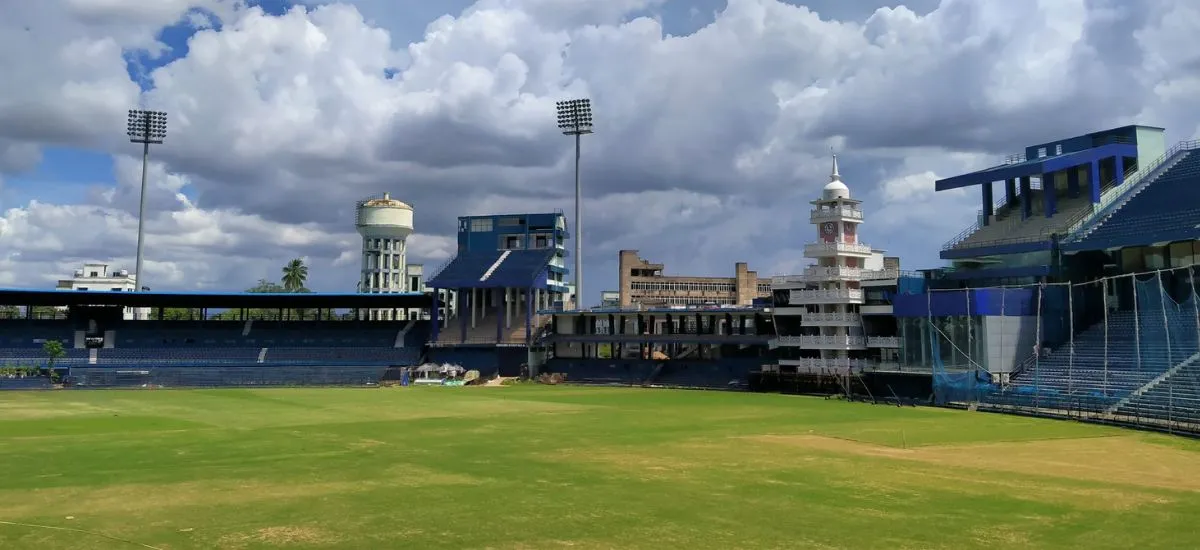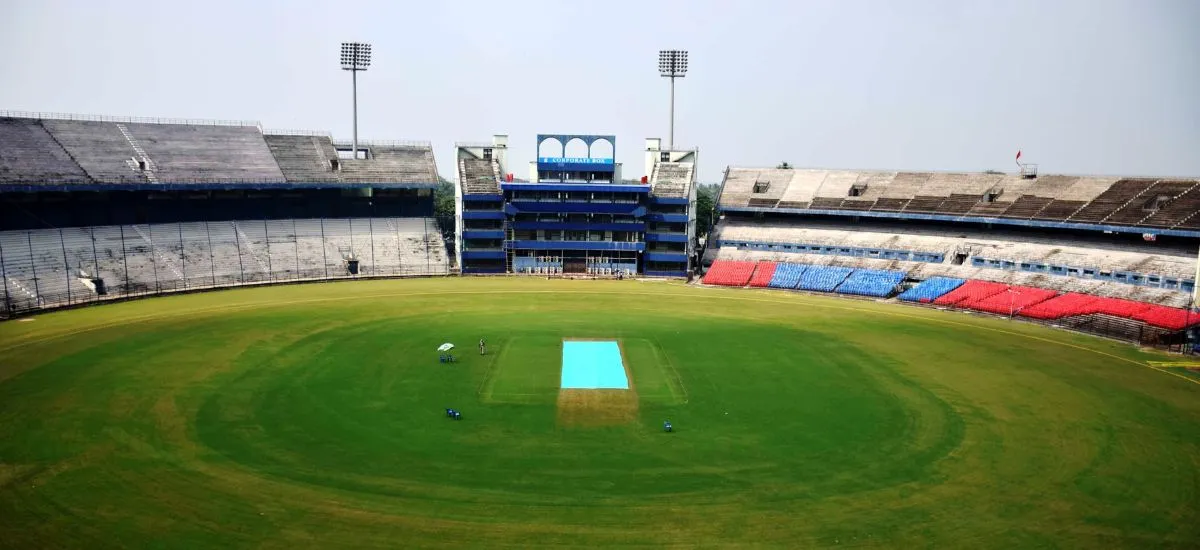Barabati Stadium is a cricket stadium located in Cuttack, Odisha, India. The stadium was built in 1958 and has a seating capacity of 45,000. It is the home ground of the Odisha cricket team and the Cuttack district team. The stadium has hosted numerous domestic and international cricket matches, including One Day Internationals (ODIs) and Twenty20 Internationals (T20Is).
The Barabati Stadium is known for its unique location, as it is situated on the banks of the river Mahanadi and surrounded by the Barabati Fort. The stadium has undergone several renovations and upgrades over the years, including the installation of floodlights in 1997 and the addition of a new electronic scoreboard in 2002.
The Barabati Stadium has also played host to other sporting events, such as football and athletics, as well as cultural events and concerts. In addition to the main cricket field, the stadium also has several practice pitches, indoor and outdoor training facilities, and a gym.
Despite being a smaller stadium compared to some of the other cricket venues in India, the Barabati Stadium has a rich history and has been the site of many memorable cricketing moments. It is an important part of the sporting culture of Odisha and continues to be a popular destination for cricket fans from around the country.
Barabati Stadium Geographics

Weather Conditions- Cuttack, where the Barabati Stadium is located, has a tropical savanna climate with hot and humid weather throughout the year. The city experiences three main seasons: summer, monsoon, and winter.
Summer, which lasts from March to June, is the hottest season with temperatures ranging from 35 to 45 degrees Celsius (95 to 113 degrees Fahrenheit). The humidity levels are also high during this time, making the weather feel even hotter.
The monsoon season, which lasts from June to September, brings heavy rains and strong winds to the region. The weather is generally cooler and more pleasant during this time, with temperatures ranging from 25 to 35 degrees Celsius (77 to 95 degrees Fahrenheit).
Winter, which lasts from November to February, is the coolest season with temperatures ranging from 15 to 25 degrees Celsius (59 to 77 degrees Fahrenheit). The weather is generally dry and sunny during this time, making it a good time to visit the stadium.
Area And Boundary Size- between 65M and 70M
Location- FVJ9+7CM, Stadium Rd, Biju Patnaik Colony, Cuttack, Odisha 753008
Capacity- 45,000
Co-ordinates- 20.4807° N, 85.8686° E
Barabati Stadium Essentials
Ticket Price
1. T20I- INR 1900 – INR 12,000.
2. ODI- INR 600 – INR 8,000.
3. Test- INR 200- INR 5000.
4. IPL – INR 700 – INR 8,000.
Nearby hotels
- Hotel New Grand: This budget hotel is located just 500 meters from Barabati Stadium and offers air-conditioned rooms with private bathrooms. It has an average rating of 3.5 out of 5 stars based on customer reviews.
- Hotel Surya: This 3-star hotel is located just 1 kilometer from Barabati Stadium and offers air-conditioned rooms with private bathrooms, as well as an on-site restaurant. It has an average rating of 3.5 out of 5 stars based on customer reviews.
- Hotel Swosti Premium: This 4-star hotel is located about 1.5 kilometers from Barabati Stadium and offers a variety of amenities, including an outdoor pool, a spa, and an on-site restaurant. It has an average rating of 4 out of 5 stars based on customer reviews.
- Hotel The Presidency: This 3-star hotel is located about 2 kilometers from Barabati Stadium and offers air-conditioned rooms with private bathrooms, as well as an on-site restaurant. It has an average rating of 3.5 out of 5 stars based on customer reviews.
- Hotel Udai Continental: This 4-star hotel is located about 2.5 kilometers from Barabati Stadium and offers a variety of amenities, including an outdoor pool, a spa, and an on-site restaurant. It has an average rating of 4 out of 5 stars based on customer reviews.
Recommended: Who Is The King Of IPL?
Barabati Stadium Pitch Report
The wickets used for cricket matches have a reputation for producing inconsistent bounce, which can be especially helpful for spin bowlers. This has been demonstrated by the success of spin bowlers such as Anil Kumble, Narendra Hirwani, and Maninder Singh on these wickets.
For example, Hirwani’s impressive performance of taking six wickets in a single match against New Zealand in 1995 is a testament to the beneficial conditions for spin bowlers on these pitches. However, it is also worth noting that fast bowlers have also been able to take advantage of the variable bounce on occasion and have had their own successes on these wickets
Barabati Stadium Statistics
Test
Total matches- 3
Matches won batting first- 1
Average 1st Inns scores- 293
Average 2nd Inns scores- 223
Average 3rd Inns scores- 199
Highest total recorded- 400/10 (127.3 Ov) by IND vs SL
Lowest total recorded- 142/10 (59 Ov) by SL vs IND
ODI
Total Match Played: 19
Batting First Won: 8
Batting Second Won: 11
Tie: 0
Avg. Score in 1st bat: 249
Highest Score: India 381/6
Lowest Score: Pakistan 148/9
T20I
Total Match Played: 2
Batting First Won: 1
Batting Second Won: 1
Tie: 0
Avg. Score in 1st bat: 136
Highest Score: India 180/3
Lowest Score: Sri Lanka 87/10
IPL
Total Match Played: 5
Batting First Won: 2
Batting Second Won: 3
Tie: 0
Avg. Score in 1st bat: 167
Highest Score: Punjab Kings 231/4
Lowest Score: Deccan Chargers 126/7
Barabati Stadium Records

- Highest team score: The highest team score at the Barabati Stadium was achieved by India in an ODI match against Australia in 1997, when they scored 356 runs.
- Highest individual score: The highest individual score at the Barabati Stadium was made by Sourav Ganguly, who scored 183 runs in an ODI match against Sri Lanka in 1997.
- Best bowling figures: The best bowling figures at the Barabati Stadium were recorded by Brett Lee, who took 5 wickets for 42 runs in an ODI match against India in 2007.
- Most catches: The record for the most catches taken at the Barabati Stadium is held by Mahendra Singh Dhoni, who took 4 catches in an ODI match against West Indies in 2011.
- Most run-outs: The record for the most run-outs at the Barabati Stadium is held by Yuvraj Singh, who was responsible for 3 run outs in an ODI match against West Indies in 2011.
- Highest attendance: The highest attendance at the Barabati Stadium was recorded during an ODI match between India and Australia in 1997, when over 60,000 spectators were in attendance.
5 Interesting Facts about Barabati Stadium
The Barabati Stadium, located in Cuttack, Odisha, India, is a multi-purpose sports venue that is primarily used for cricket matches. The stadium was built in 1958 and has undergone several renovations since then, including the addition of floodlights in 1997 to enable night matches.
The Barabati Stadium has a seating capacity of 45,000 spectators, making it one of the larger cricket grounds in India. The stadium has hosted numerous international cricket matches, including both Test and One Day International (ODI) matches, as well as domestic cricket matches.
The Barabati Stadium has a reputation for producing wickets with inconsistent bounce, which can be particularly helpful for spin bowlers. This has been demonstrated by the success of spin bowlers such as Anil Kumble, Narendra Hirwani, and Maninder Singh on these wickets. However, fast bowlers have also been able to take advantage of the variable bounce on occasion and have had their own successes on these wickets.
The Barabati Stadium has hosted some memorable cricket matches over the years, including the ODI match between India and Australia in 1997, in which India set a record for the highest team score at the stadium by scoring 356 runs. The highest individual score at the Barabati Stadium was made by Sourav Ganguly, who scored 183 runs in an ODI match against Sri Lanka in 1997.
In addition to cricket, the Barabati Stadium has also hosted other sporting events, such as football and hockey matches, as well as concerts and other cultural events. The stadium has a multi-purpose indoor hall that can be used for a variety of purposes, including indoor sports and events. The Barabati Stadium is a major sporting venue in the region and attracts a large number of spectators for the various events held there.
Frequently Asked Questions
1. Does Barabati Stadium have AC?
Yes, It has 7 Gallery for spectators, 2 Special enclosure block, 2 AC box, 1 corporate box and a Club house.
2. Is Barabati Stadium a batting pitch?
It is difficult to make a generalization about the nature of the pitch at the Barabati Stadium in Cuttack, Odisha, India as the conditions of the pitch can vary from match to match and can be influenced by various factors such as the weather and the nature of the surface. However, the pitch at the Barabati Stadium is known for producing variable bounce and assisting spin bowlers, which can make it difficult for batsmen to predict how the ball will behave when they play their shots. This may make the pitch more challenging for batsmen, particularly if they are facing skilled spin bowlers. However, it is also worth noting that batsmen can still score runs on this pitch if they are able to adapt to the conditions and play their shots effectively.
3. Which is the smallest cricket ground in India?
The Chinnaswamy Stadium in Bangalore, India is known to be one of the smallest cricket grounds in the country. The stadium has a seating capacity of around 40,000 spectators and has hosted both international and domestic cricket matches. It is known for its small boundaries, which make it a high-scoring ground and a favorable venue for batsmen. The Chinnaswamy Stadium is also home to the Royal Challengers Bangalore team in the Indian Premier League (IPL), a Twenty20 cricket league.
4. How is the pitch of Barabati Stadium?
The pitch at the Barabati Stadium in Cuttack, Odisha, India is known for producing variable bounce and assisting spin bowlers. This means that the ball bounces differently at different points on the pitch, which can make it difficult for batsmen to predict how the ball will behave when they play their shots. Spin bowlers, who rely on the ball turning or bouncing unexpectedly, often benefit from these conditions. However, fast bowlers can also take advantage of the variable bounce on occasion and have had their own successes on these wickets. It is worth noting that the conditions of the pitch can vary from match to match and can be influenced by factors such as the weather and the nature of the surface.
Check This: T20 World Cup Winners List From 2007 To 2002

